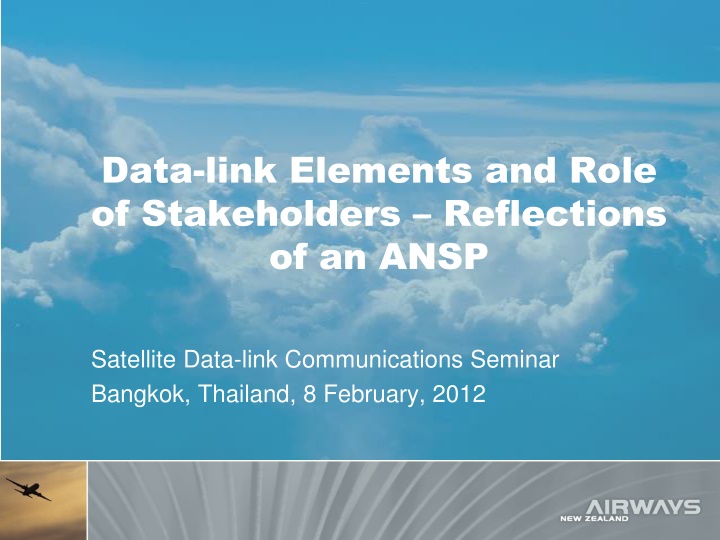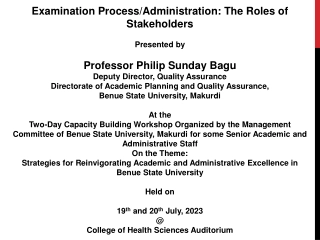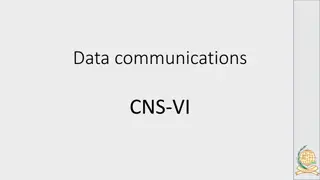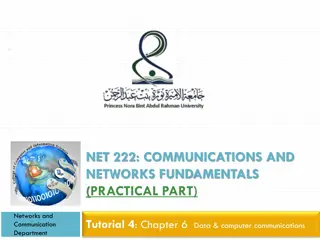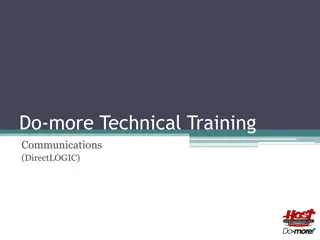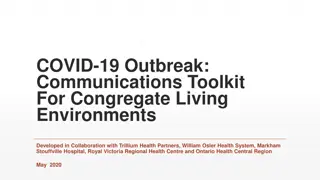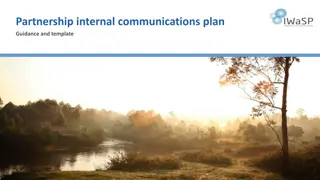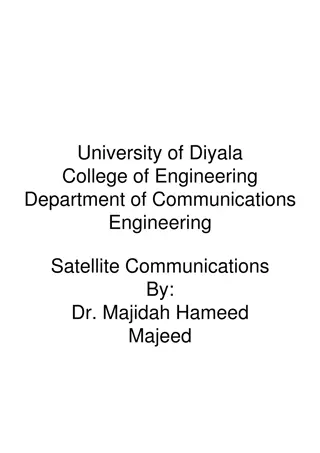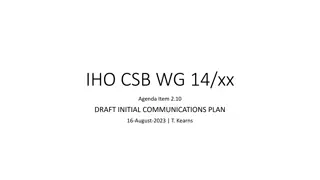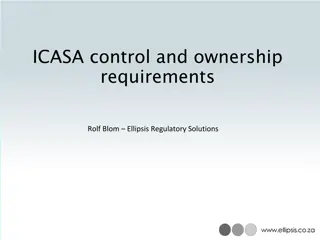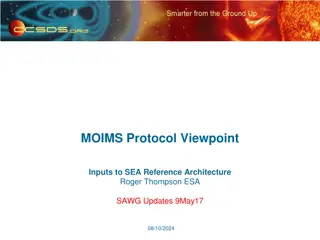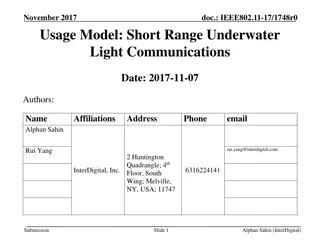Elements and Role of Stakeholders in Data-link Communications
Reflections from an ANSP Satellite Data-link Communications Seminar in Bangkok, Thailand, discussing the importance of stakeholders, operational improvements enabled by FANS1/A CPDLC and ADS-C data-link, global plans for a performance-based system, and the importance of monitoring safety standards.
Download Presentation

Please find below an Image/Link to download the presentation.
The content on the website is provided AS IS for your information and personal use only. It may not be sold, licensed, or shared on other websites without obtaining consent from the author.If you encounter any issues during the download, it is possible that the publisher has removed the file from their server.
You are allowed to download the files provided on this website for personal or commercial use, subject to the condition that they are used lawfully. All files are the property of their respective owners.
The content on the website is provided AS IS for your information and personal use only. It may not be sold, licensed, or shared on other websites without obtaining consent from the author.
E N D
Presentation Transcript
Data-link Elements and Role of Stakeholders Reflections of an ANSP Satellite Data-link Communications Seminar Bangkok, Thailand, 8 February, 2012
Data-link - Enabling Benefits Operational improvements using FANS1/A CPDLC and ADS-C data-link are predicated on certain communications, surveillance, and navigation requirements. We have an obligation to ensure that aircraft and operators are meeting these requirements. Operational improvements from FANS1/A data-link are often supported by other infrastructure e.g. ground system automation and AIDC if the data-link benefits are to be fully implemented with an appropriate level of safety. Improvements with global applicability need globally agreed procedures.
Data-link A performance based system? ICAO global plan requires a performance based system. Regional Implementation Plan for performance based navigation. A Regional Implementation Plan for performance based communication and surveillance has been recommended. ICAO Annex 11 requires monitoring of performance to verify an acceptable level of safety continues to be met
A Performance Based System ---- Corrective Corrective action action afety s FANS 1/A Advance Avionics supplier Continuous improvement Aircraft manufacturer Satellite company CSP Operator Network ATSP CPDLC RCP & ADS-C safety performance monitoring Central Reporting Agency FANS 1/A
Missing bits of jigsaw RCP? - RSP? VDL2? VHF? RNP4 POA? RCP240? Inmarsat I3? RCP400? Inmarsat I4? RNP4 SATCOM? Iridium? RNP4 RNP4 RSP180? RNP4 MTSAT? RNP from FPL RSP400? RNP4 RNP4 HFDL? RCP/RSP from ? RNP10 4 SATCOM +HFDL?
RSP/RCP ICAO 2012 FPL Currently, there is potential for an ANSP to misapply Air Traffic Services to an operator or aircraft type. Current amendment to Doc4444 for FPL 2012 makes provision for RCP allocation in Field 10 but does not assign values to the designators. No similar provision was made for RSP allocation in Field 10 but does mention use of SUR/ in Field 18. OPLINKP have agreed that in ICAO FPL: For RCP Field 10a - P1=RCP240 and P2 = RCP400 For RSP Field 18 use SUR/RSP180 or SUR/RSP400 Consider a Doc7030 amendment to mitigate this issue?
ANSP Ground System Automation With proliferation of different aircraft equipment, technology, and wide variations in observed performance, there is an urgent need for improved ground system automation. While some guidance is provided in the GOLD 3.1.2 additional guidance is required in the area of ground system automation that will assist controllers to enable benefits. Some areas under consideration: Mitigate risk of inadvertent application of D50/D30 to RNP qualified aircraft that do not qualify by filed/ observed RSP/RCP using system interlocks. Improved controller HMI
ANSP Supporting infrastructure Implementing FANS1/A CPDLC and ADS-C in isolation without considering the supporting infrastructure will restrict/delay operational benefits: In Oceanic/Remote airspace significant benefits can be realised through DARP. DARP requires AIDC to communicate route changes to downstream ANSP. No AIDC = No DARP. Recent I3 failure 22 October 2011 in Pacific is a good example where supporting infrastructure could do better.
Supporting infrastructure NZZO case study A 910 minute outage of the Inmarsat POR satellite occurred at 0900 UTC on 22 October NZZO received SITA notification of failure at 0939 UTC NZZO received ARINC notification of failure at 1248 UTC At 08:54UTC the on-board Frequency Generation System switched off unexpectedly causing a total Payload outage. This is classified as a rare Single Event Upset (SEU) by Inmarsat NZZO observed Inmarsat contingency arrangements commence using the I2 satellites at 1956UTC via AOE2 Perth and XXC Santa Paula I do not believe any ANSP has seen a final report on this outage detailing lessons learnt and areas for improvement. Feedback and communication are at the core of any performance based system.
Supporting infrastructure NZZO case study Eight aircraft were operating FANS1/A at time of failure: 1 B772 MTSAT unaffected 1 B744 SITA POR1 switched to MTSAT unaffected 1 military operating Arinc XXC switched to HFDL 1 A340 operating Arinc XXC switched to AOW via XXE - unaffected 2 B744 operating Arinc XXC lost data-link 1 A388 operating SITA POR1 switched to HFDL 1 B744 operating SITA POR1 lost data-link During the failure period: A332 and A388 normally operating HFDL in next on busy mode operated HFDL. Only 1 CPDLC transaction with ACP 201 seconds, 16 ADS-C downlinks with only 75% meeting RSP400 95% 300 and 81% meeting RSP400 99.9% 400 A388 operating Inmarsat I4 unaffected B772/B744 operating MTSAT unaffected
Supporting infrastructure NZZO case study Some food for thought: The small number of aircraft that appear to have MTSAT configured in their ORT s Why can t aircraft switch I3 to I4? Observed HFDL performance poor Nearly six months after the event still no final report: what are lessons learnt? what can be improved?
GOLD Global Operational Data-link Manual A significant step towards global standard procedures: Appendix B & C provides guidance on RCP and RSP performance specifications. Appendix D provides guidance on post implementation monitoring and corrective action. Chapter 4 provides Controller procedures Chapter 5 provides Flight Crew procedures While adopted by ANPANPIRG it is still an important work in progress.
Thank you Paul Radford Manager Oceanic Systems Airways New Zealand paul.radford@airways.co.nz
